Intelligence
A Problem Well-Stated Is a Problem Half-Solved: The Options
Improving cognitive flexibility to meet today’s challenging world, Part 2.
Posted March 5, 2021 Reviewed by Hara Estroff Marano
My last blog provided an exercise with multiple solutions—but not the answers so that you would have the opportunity to try it for yourself. Herewith are the various possible answers and what they can tell about your thought processes.
The exercise asks you to fill in the first and last blank square in the progression.

Now let’s take a look at the possible answers and what they tell us about thought processes. The answer that you found first says a lot about how you process information and solve problems. The answer reflects a pattern in your thinking behavior. That doesn’t mean that you can’t see the other answers, it just means that you habitually begin to think about things in a certain manner. You will likely find more than one answer as you continue to think about the exercise. Note the answers below are not in any particular order, so this is not necessarily the order in which you should find the possible answers.
The first possibility is H in the first box and B in the fourth box, where there are changes in color and position. A person who chooses this answer identifies changes from box 2 to 3 and then selects H and B because that answer is consistent with the changes identified in boxes 2 and 3. A person who thinks this way is a “Left to righter.” “Left-to-righters” want guarantees. They appear well-organized and like to do things in a step-by-step orderly manner. Any deviation from the norm makes them uncomfortable.
Left-to-righters don’t see how they could have done things differently. They were so careful to do everything right that mistakes couldn’t have been made. But if they were made, someone else was at fault for not providing the Left-to-righter with precise information in the prescribed way. Left-to-righters are rarely aware of visualizing but their behavior suggests that their self-image is closely tied to their achievements and success. Left-to-righters are particularly good at solving problems that require established routines. People identify them as natural leaders because they seem to know how to get things done right. Their strength lies in achieving simple, short-term goals.
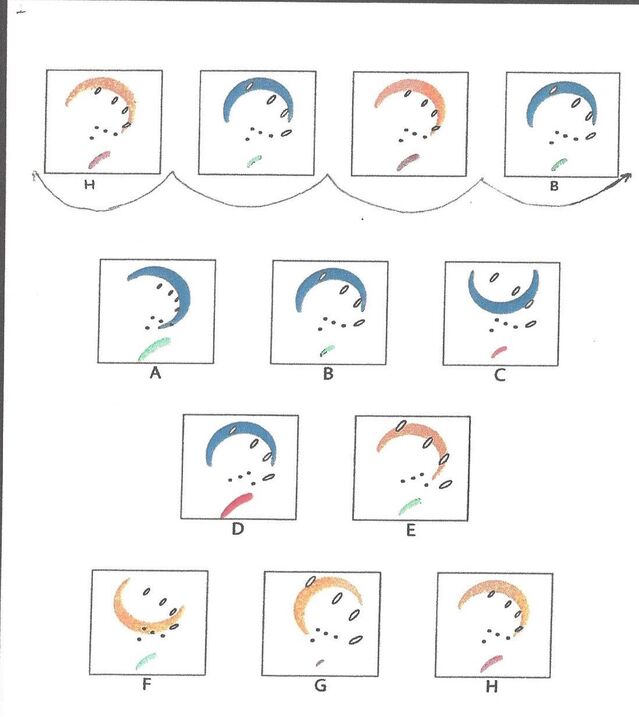
Second is C and F. From the first box to the fourth box are changes in position (inversion) and color (the small image at the bottom). People for whom this is the initial answer are “Disconnectors.” They see the blue as the dominant feature and use the blue as the connection and the inversion as secondary. “Disconnectors” have difficulty visualizing future possibilities.
They may be highly knowledgeable on a specific subject, their minds virtual data banks of information just waiting to be tapped. But they cannot translate their knowledge into doable actions. Consequently, for Disconnectors doing things right means keeping everything in its preordained place. Disconnectors are particularly good at explaining how things are. They’ll say what other people want to hear and think their responsibility ends there. They can easily overlook missing pieces because they have a feel for the operation as a whole. But in a complex system, small changes can have major consequences. Ignoring a missing piece can lead to dumb mistakes.
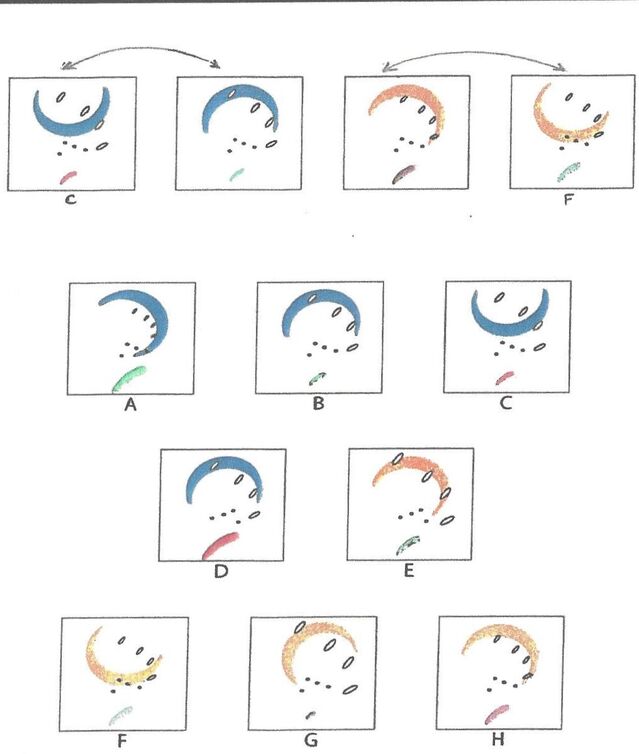
A third possibility is F and C. From the first box to the fourth box are changes in orientation and color. People who readily found this answer are “Central Shapers.” This is a complex progression where the connections are not next to each other but skip over a box. The world isn’t linear and they are comfortable with the chaos. Pattern detection is the forte of “Central Shapers.”
If we could project an image of their minds at work, they would look like Swiss watches—complex, interactive mechanisms that are a delight in accuracy and detail. Central Shapers can clearly visualize a desired result. However, they are less interested in the result than they are in finding an elegant means of achieving it. Even after the problem’s been solved, they will go back over the details, looking for a better way to solve it the next time. Central Shapers are obsessed with crossing all the “Ts” and dotting all the “Is” in order to find a more perfect solution.
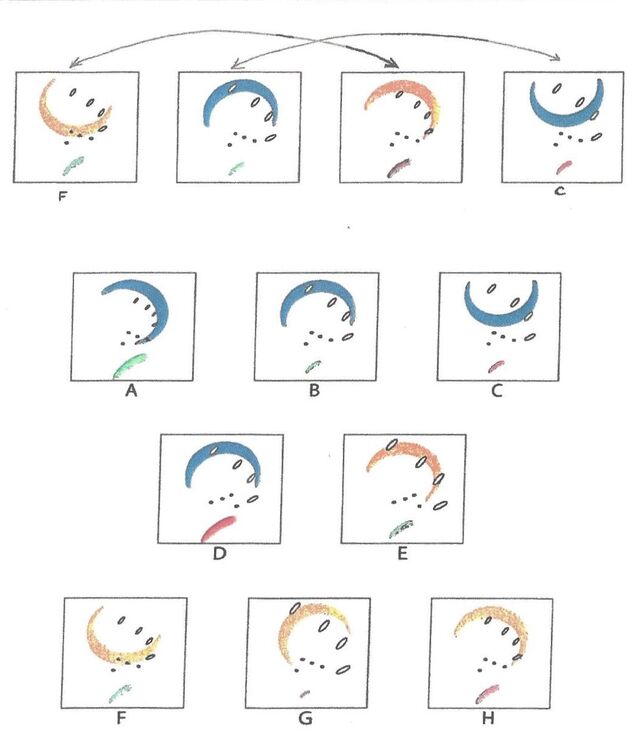
Next is D and E. From the first box to the fourth box are changes in color, orientation, and size. Seeing this solution requires getting to the nitty-gritty quickly, and these people are “Outliners.” “Outliners” have a knack for “flashbulb” thinking, they begin by matching blue and orange. Their minds work like cameras—snapping the big picture, capturing the moment. They recognize opportunities when they see them.
But by not having time to focus, the images are often blurred. Their visualizations and their verbal explanations frequently lack detail. However, they make up for their shortcomings with great enthusiasm. Doing things right, for Outliners, means getting everyone on board.
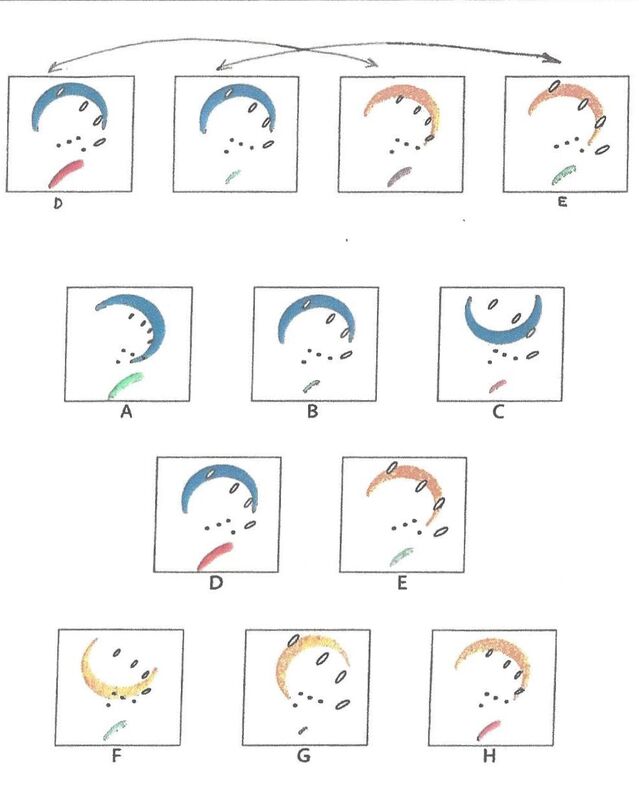
Next is D and E’s inverse, E and D. From the first box to the fourth box are changes in color, size, and orientation. These people are “Random Connectors.” “Random Connectors” don’t have to fill in all the missing pieces before arriving at a conclusion. They are result-oriented provided the result is maintaining the status quo. They have more of a feel for how the pieces fit together than a conscious visual image. Masters at networking, they think they’ve done things right if they have the “right people” on their team.

There is also A and G. From the first box to the fourth box are changes in orientation and color. As their answer suggests, these people are “Direction Changers.” As the name implies “Direction Changers” do not adhere to a specific goal. Direction Changers can quickly perceive patterns of behavior, but they do so on a subconscious level. They have an almost eerie ability to predict cultural changes or read the boss’s mood. Their underdeveloped visual skills prevent them from acting on their intuitions in a timely manner. Consequently, most of their efforts involve doing things right by not fully committing to anything at all.
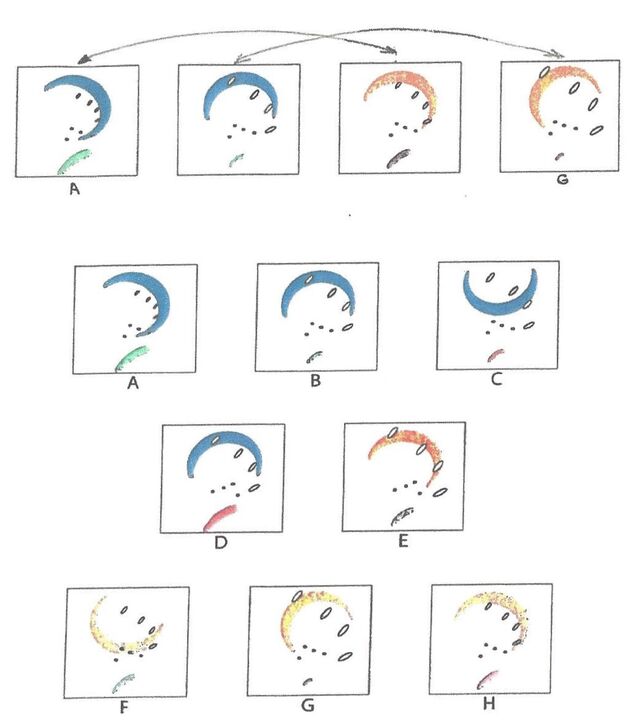
Finally, there is G and A. From the first box to the fourth box are changes in color and size. People drawn to this answer are “Creators.” “Creators” are “of the moment” people. Nothing excites them more than a new opportunity. They are innovators capable of quickly sketching out the next big thing. Just don’t ask them to get into the details or how they expect to get from here to there. For Creators, doings things right means coming up with something new to do.
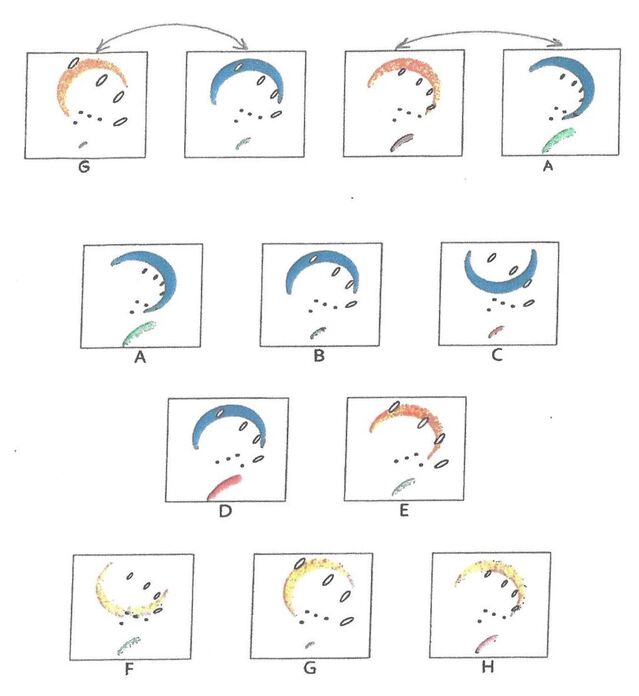
This exercise requires mental agility. Most people come up with three to four possible answers. Each answer represents a way of looking at the world and seeing patterns. The important part is the process, not which answer you necessarily came up with but the thinking that went into your answer, and how you explain and justify that thought process. Mental agility is the ability to see information from different perspectives, which reduces impulsivity and helps you navigate a dynamic and complex environment.




